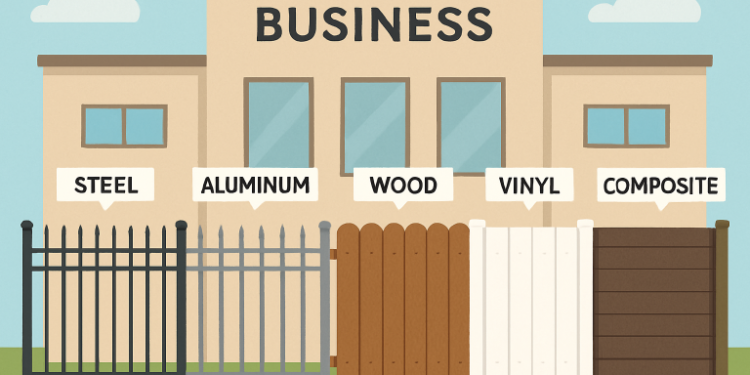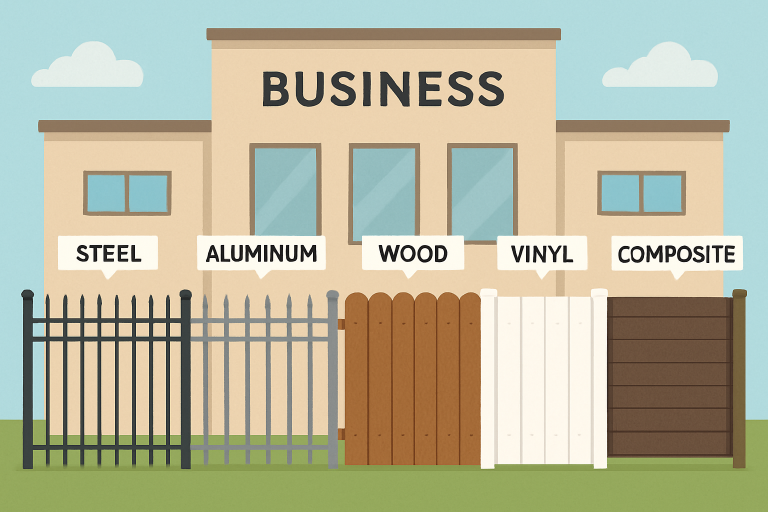Choosing the Right Fencing Material for Your Commercial Property: Trends, Durability, and Environmental Factors

Table of Contents
- 1 Introduction: The Importance of Commercial Fencing
- 2 Trending Fencing Materials
- 3 Evaluating Durability: Comparing Lifespan and Maintenance
- 4 Environmental Factors: Choosing Materials for Longevity and Sustainability
- 5 Cost-Benefit Analysis: Balancing Budget and Performance
- 6 Safety and Security: Meeting Industry Standards
- 7 Curb Appeal and Brand Image: Fencing as a Business Statement
- 8 Conclusion: Strategic Fencing for Long-Term Business Success
Introduction: The Importance of Commercial Fencing
For every commercial property owner, establishing a firm, secure boundary is more than just a practical requirement—it’s an investment in safety, privacy, and professional image. Fencing plays a vital role in protecting assets, regulating access, and enhancing the appearance of a business facility. With the ever-changing landscape of property development and security threats, it’s crucial to assess a property’s unique needs, including compliance with local business regulations.
Today’s property managers are seeking fencing solutions that not only address core concerns, such as safety and privacy, but also enhance the curb appeal and brand value of their premises. Striking a balance between aesthetics and function, businesses are prioritizing wise choices in materials, installation, and design. Exploring commercial fencing options ensures that businesses can achieve these objectives efficiently and in compliance with today’s standards. Additionally, selecting the proper fencing can add value to a property, making it more appealing to potential tenants or buyers. Regular maintenance and updates to fencing systems can prolong their lifespan and preserve their functionality. Overall, investing in quality fencing is a strategic move that benefits not only the security but also the long-term reputation of a commercial property.
Trending Fencing Materials
A blend of contemporary design, robust material science, and sustainable practices influences the commercial fencing market. Steel and aluminum remain popular due to their unparalleled strength and modern aesthetic, making them staples for industrial properties and high-security zones. Vinyl and composite materials are being increasingly embraced for their versatility and low maintenance, while also offering a range of styles and finishes that mimic the look of wood or stone. For more detailed comparisons of fencing materials, you can visit Better Homes & Gardens. Many businesses are now considering not only durability but also the long-term maintenance costs when selecting fencing. Modern fences can also enhance curb appeal, creating a professional and inviting exterior for commercial properties. In addition, technological advancements such as powder-coated finishes and rust-resistant coatings are extending the lifespan of metal fences. Sustainability has emerged as a key decision factor as businesses strive to minimize their environmental impact. Recycled materials and eco-friendly composites are in high demand.
Evaluating Durability: Comparing Lifespan and Maintenance
Choosing the right fencing material hinges on durability and ongoing upkeep. Traditional wood, while attractive, typically requires regular maintenance such as staining and sealing, with an average lifespan of 10-15 years. In contrast, metal options such as steel and aluminum can last up to 30 years or more, especially if coated to reduce rust and corrosion.
Synthetic fences made from vinyl or composite blends often come with warranties of 20 years or more and boast exceptional resistance to rot, pests, and UV exposure. These materials are engineered to withstand the extremes, requiring little more than occasional cleaning to remain in top condition. Factoring in these maintenance obligations is crucial for an accurate cost of ownership projection over the fence’s life.

Environmental Factors: Choosing Materials for Longevity and Sustainability
The local environment is a crucial factor in selecting materials for any commercial fence. Areas with heavy rainfall or humidity may accelerate wood rot, while coastal regions face increased risks of salt-induced corrosion on metal. Extreme heat and direct sunlight can cause certain plastics to degrade or lead to fading. Business owners are increasingly turning to eco-friendly alternatives—such as recycled metal, reclaimed wood, and sustainable composites—recognized for their minimal environmental impact.
Cost-Benefit Analysis: Balancing Budget and Performance
The initial price tag of a commercial fence varies dramatically depending on materials, design complexity, and installation requirements. While wood or chain-link fencing often carries lower upfront costs, it may require higher maintenance expenses and necessitate earlier replacement. Metal and synthetic options, while higher in initial installation costs, typically result in lower long-term expenses due to reduced upkeep and greater longevity.
Wise investment decisions factor in total cost of ownership, financing options, and the potential for a positive return, especially for property managers tasked with maximizing operational budgets. Every fencing choice should be evaluated not only for its fit with operational needs but also for its contribution to asset value and workplace security.
Safety and Security: Meeting Industry Standards
Perimeter security has never been more critical, particularly for commercial and industrial sites that store valuable equipment or proprietary information. Security-grade fences often feature anti-climb designs, tamper-resistant hardware, and advanced materials that deter intrusion or vandalism. Customizable fencing options allow for integration with access control systems and visibility solutions, ensuring compliance with both safety codes and insurance requirements. Standards set by organizations like ASTM International provide benchmarks for impact resistance, structural integrity, and security features.
Curb Appeal and Brand Image: Fencing as a Business Statement
Beyond practical considerations, fencing can serve as a unique expression of a company’s ethos and attention to detail. Custom colors, decorative accents, and branding elements help seamlessly blend security infrastructure with a business’s landscape design and architecture. By investing in well-designed fencing, companies create a positive and professional first impression for customers, employees, and visitors alike.
Conclusion: Strategic Fencing for Long-Term Business Success
Investing in commercial fencing goes far beyond simply marking property boundaries. It combines safety, durability, environmental responsibility, and visual appeal to support both operational efficiency and brand image. By carefully evaluating materials, maintenance requirements, environmental conditions, and long-term costs, business owners can select fencing solutions that provide lasting protection while complementing the overall aesthetic of their premises.
Ultimately, a well-chosen fence enhances security, ensures regulatory compliance, and creates a professional, welcoming environment—making it a strategic asset rather than just a functional necessity.






